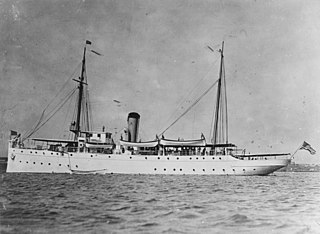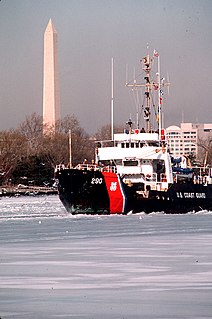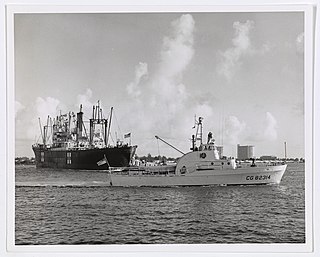
USCGC Mesquite (WAGL/WLB-305) was the lead ship in the Mesquite class of seagoing buoy tenders operated by the United States Coast Guard. She served in the Pacific during World War II, and spent the rest of her Coast Guard career in the Great Lakes. She ran aground and was wrecked in December 1989 off the Keweenaw Peninsula in Lake Superior. She was scuttled nearby as a recreational diving attraction.

USCGC Acushnet (WMEC-167) was a cutter of the United States Coast Guard, homeported in Ketchikan, Alaska. She was originally USS Shackle (ARS-9), a Diver-class rescue and salvage ship commissioned by the United States Navy for service in World War II. She was responsible for coming to the aid of stricken vessels and received three battle stars during World War II, before a long career with the Coast Guard. Acushnet patrolled the waters of the North Pacific and was one of the last World War II era ships on active duty in the US fleet upon her retirement in 2011.

SLNS Samudura (P261) is a Sri Lanka Navy Offshore Patrol Vessel. Originally commissioned by the United States Coast Guard in 1968 as the medium endurance cutter USCGC Courageous, she was donated to Sri Lanka in 2004 and commissioned on February 19, 2005.
SS V.A. Fogg was a modified T2 tanker built in 1943, as SS Four Lakes. After service in World War II, she was eventually sold into private ownership. She was renamed V.A. Fogg in 1971, shortly before she exploded and sank off Freeport, Texas.

The Battle of the Caribbean refers to a naval campaign waged during World War II that was part of the Battle of the Atlantic, from 1941 to 1945. German U-boats and Italian submarines attempted to disrupt the Allied supply of oil and other material. They sank shipping in the Caribbean Sea and the Gulf of Mexico and attacked coastal targets in the Antilles. Improved Allied anti-submarine warfare eventually drove the Axis submarines out of the Caribbean region.

USCGC Madrona (WLB-302) was a U.S. Coast Guard 180 foot seagoing buoy tender. Madrona was built by the Zenith Dredge Company of Duluth, Minnesota at a cost of $949,144.

USS Unimak (AVP-31) was a United States Navy Barnegat-class small seaplane tender in commission from 1943 to 1946 that saw service in World War II. After the war, she was in commission in the United States Coast Guard as the cutter USCGC Unimak (WAVP-379), later WHEC-379, WTR-379, and again WHEC-379, from 1949 to 1975 and from 1977 to 1988.

USS Enoree (AO-69) was a Chiwawa-class oiler constructed for the United States Navy during World War II. She was the only U.S. Navy ship named for the Enoree River in South Carolina.
USS Sequatchie (AOG-21) was a Mettawee-class gasoline tanker acquired by the U.S. Navy for the dangerous task of transporting gasoline to warships in the fleet, and to remote Navy stations.
USS Narraguagas (AOG-32) was a Mettawee-class gasoline tanker acquired by the U.S. Navy for the dangerous task of transporting gasoline to warships in the fleet, and to remote Navy stations.

USCGC Androscoggin (WHEC-68) was an Owasco-class high endurance cutter built for World War II service with the United States Coast Guard. The war ended before the ship was completed and consequently Androscoggin did not see wartime service until the Vietnam war.

USCGC Tallapoosa (WPG-52) was a United States Coast Guard cutter of the Tallapoosa-class and was designed to replace the revenue cutter Winona. Her hull was reinforced for light icebreaking. She was initially stationed at Mobile, Alabama, with cruising grounds to Lake Pontchartrain, Louisiana and Fowey Rocks, Florida. During World War I she escorted convoys out of Halifax, Nova Scotia. After the war she served with the Bering Sea Patrol before returning to Savannah, Georgia before World War II. During the war Tallapoosa assisted with convoy escort duty and anti-submarine patrols.

USCGC Tampa (ex-Miami) was a Miami-class cutter that initially served in the U.S. Revenue Cutter Service, followed by service in the U.S. Coast Guard and the U.S. Navy. Tampa was used extensively on the International Ice Patrol and also during the Gasparilla Carnival at Tampa, Florida and other regattas as a patrol vessel. It was sunk with the highest American naval combat casualty loss in World War I.

USS Matagorda (AVP-22/AG-122) was a United States Navy Barnegat-class seaplane tender in commission from 1941 to 1946 that saw service in World War II. After the war, she was in commission in the United States Coast Guard as the cutter USCGC Matagorda (WAVP-373), later WHEC-373, from 1949 to 1967.

USS Rockaway (AVP-29), later AG-123, was a United States Navy Barnegat-class seaplane tender in commission from 1943 to 1946. She served in both the Atlantic Ocean and the Pacific Ocean during World War II. In 1948, she was loaned to the United States Coast Guard, in which she served as the cutter USCGC Rockaway (WAVP-377), later WAGO-377, WHEC-377, and WOLE-377, from 1949 to 1972.
USRC Forward was a revenue cutter constructed for the U.S. Revenue Cutter Service in 1882 by Pusey & Jones shipyard in Wilmington, Delaware. She was the second Revenue Cutter Service vessel named Forward and was named for Walter Forward, the fifteenth United States Secretary of the Treasury. The iron-hulled vessel originally cost US$72,750 and was powered by a two-cylinder steam engine with a topsail schooner brigantine sail pattern. Although Forward was considered a model ship at the time of its construction, it was severely underpowered and had unreliable machinery. The cost of repairs in the first fifteen years of operation was US$52,000.

For other ships of the same name, see ARC San Andres

USCGC Bernard C. Webber (WPC-1101) is the first of the United States Coast Guard's 58 Sentinel-class cutters. Like most of her sister ships, she replaced a 110-foot (34 m) Island-class patrol boat. Bernard C. Webber, and the next five vessels in the class, Richard Etheridge, William Flores, Robert Yered, Margaret Norvell, and Paul Clark, are all based in Miami, Florida.

USCGC Point Thatcher (WPB-82314) was an 82-foot (25 m) Point class cutter constructed at the Coast Guard Yard at Curtis Bay, Maryland in 1961 for use as a law enforcement and search and rescue patrol boat. Since the Coast Guard policy in 1961 was not to name cutters under 100 feet (30 m) in length, it was designated as WPB-82314 when commissioned and acquired the name Point Thatcher in January 1964 when the Coast Guard started naming all cutters longer than 65 feet (20 m). Point Thatcher was unique because it was the only cutter that was built in the class that was powered using gas turbine main drive engines.

USS YF-416 was an American YF-257-class covered lighter built in 1943 for service in World War II. She was later acquired by the United States Coast Guard and renamed USCGC White Sumac (WAGL-540).
















